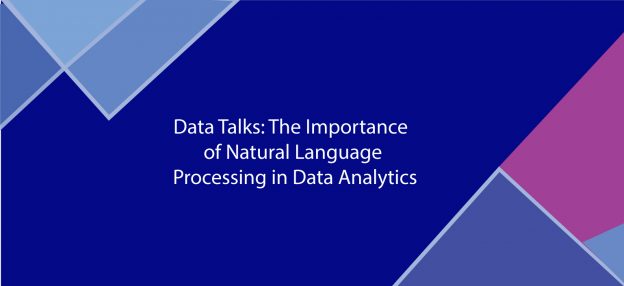Data Talks: The Importance of Natural Language Processing in Data Analytics

An IDC Digital Universe Study reports that by 2020, for every human in the world, approximately 1.7 megabytes of new information will be created every second; that’s around 44 trillion gigabytes of digital knowledge worldwide.
In this age of big data pools, data comprises mainly text information like customer and sales information, transactional data, and research, along with external open-sourced information and social media. This data is constantly growing and primarily unstructured. It is also in natural language, which can be defined as the automated manipulation of the way humans talk (i.e. speech and text in natural language) by software.
Before getting into the relevance of NLP in data analytics, let’s delve into the fundamentals.
Natural Language Processing is a field of Artificial Intelligence (AI) that assists machines in reading the text through simulation of humans’ ability to understand language. NLP uses various methods which include linguistics, semantics, statistics, and machine learning for extracting entities, relationships, and understanding context. This ensures that whatever is written or spoken is comprehensively understandable.
NLP assists computers in understanding sentences and sentiments as spoken or written by humans rather than merely decoding words or combinations. It deploys numerous methodologies for deciphering complexities in language including automatic summarization, disambiguation, tagging of parts-of-speech, extraction of entities and elations along with comprehending and recognizing natural language.
Role and Uses of NLP in Big Data
Major organizations that operate in the medical, legal, pharmaceutical, and education sectors generate vast amounts of data from disparate sources that are archived daily. This data can be in the form of customer inputs or reviews, documents, sales information, notes, etc. This data is mainly text, so NLP is essential for obtaining valuable results from the data since unstructured data doesn’t work well with traditional rows and columns structures of relational databases.
NLP can assist businesses by simplifying tasks and the fields of application. Let’s have a look at some of those tasks:
1. NLP for Interaction and Data-Driven Decision Making
Apple’s Siri, online banking, and self-service tools in retail and certain automatic translation programs are the most common examples of NLP-based interactive application assistants that can be used on smartphones. The users pose questions in casual language and get prompt and accurate responses with various other suggestions. This technology can be effectively utilized within data analytics, as data analytics tools can help business leaders, researchers, and others to gain insights that can assist them in making effective, data-driven decisions. This is indeed a win-win scenario for both the customer and the company. The customer benefits by being able to communicate easily with the company and the company benefits by structuring data and unraveling hidden relationships within the languages.
2. NLP in Business Intelligence and Informative Insights
NLP can be used with big data to efficiently extract and structure relevant data and obtain a summary of the contents from the documents that are present in large catalogs or datasets for collective insight. With NLP, users don’t have to specifically type or have an understanding of the exact keywords for extracting what they are searching for, they can use search engine queries formulated in their own words for interacting with the content. This information is retrieved swiftly with an increased speed of analytics and informative insights are curated that allow real-time actionable business decisions.
3. Sentiment Analysis
The growing number of online customers has made online mediums a rich source for extracting data from disparate sources. Whatever customers express (either verbally or in writing) consists of huge amounts of information which needs to be structured. Through sentiment analysis, organizations can find out about the popularity of their products and can work on the positive/negative feedback from the customers. Hence, sentiment analysis is a strong tool for generating data regarding the market scenarios and customers – present and prospective.
Businesses can benefit from a detailed demographic profile of their customers, their preferences, needs, habits, and so on. This information enables businesses to enhance data analytics to curate insights that can be used for developing products, implementing strategies, and changing marketing techniques.
4. Developing a Data-Driven Culture
Business intelligence (BI) powered by data analytics needed expert data professionals who were trained to solve queries and understanding results. But NLP has changed those dynamics. Experts are calling the changing dynamics “Data Democratization”, meaning that more people can access the data sets for generating insights which earlier were possible only for those with advanced skills.
With an increased number of people gathering quick insights based on data, companies benefit more from a data-driven culture. In a data-driven environment where NLP is at play, most decisions would rely on facts and evidence rather than guesswork, observation, or theories.
According to an InformationWeek article, “A few BI and analytics vendors are offering NLP capabilities but they’re in the minority for now. More will likely enter the market soon to stay competitive.”
Businesses certainly must give preference to data platforms that support NLP over others. Rawcubes’ DataBlaze is one such data platform that enables easier, real-time retrieval of data through its knowledge graph and supports both SQL and NLP for querying data. Investing in a data management platform like DataBlaze helps you consolidate big data from disparate sources, including IoT devices, to enable you to derive insights without writing a single line of code. It saves you time and money and offers you an unparalleled view of your data.
Advanced analytics can become an essential part of your strategy, but what’s most important is that your organization adopts a data-driven approach.